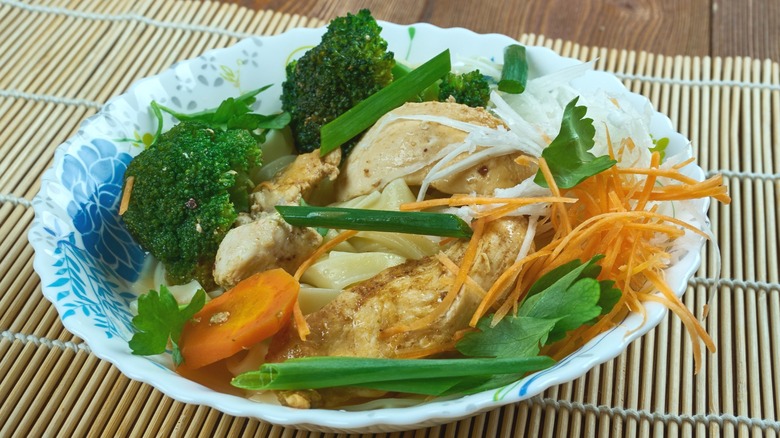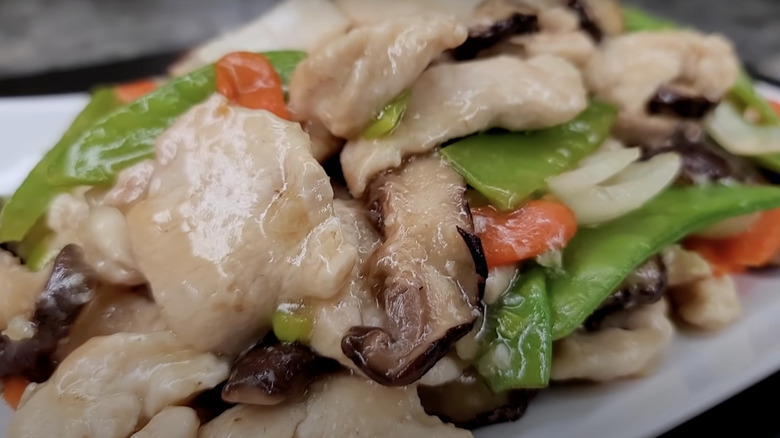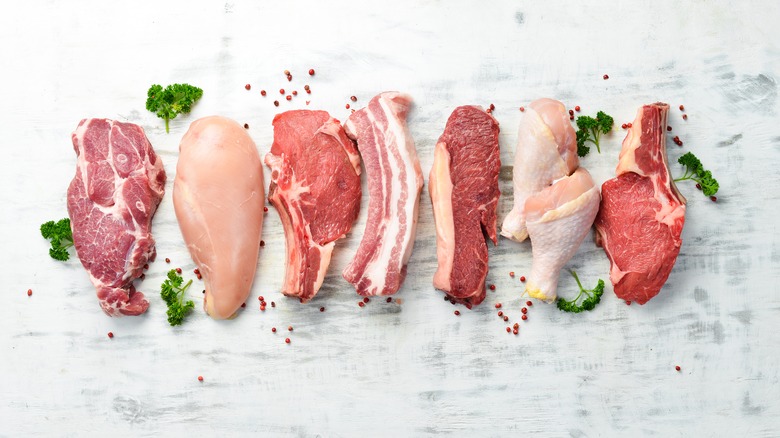The Technique That Makes Moo Goo Gai Pan Superior To Your Standard Stir-Fry
Many beloved American Chinese dishes have roots in traditional Chinese cuisine, paralleling countless other culinary creations from around the world that have taken their own delicious twists and turns since leaving their home country. Moo goo gai pan is one such example. Based on the Cantonese dish mo gu ji pian, which translates to "mushrooms and sliced chicken," the name is a transliteration that made it easier for English speakers to pronounce after it arrived in America during the 1800s.
The recipe was modified to suit Western palates and produce as well. In addition to the traditional named ingredients, you're likely to find an assortment of other items typical in American Chinese cooking — canned bamboo shoots and water chestnuts, carrots, or sugar snap peas. Moo goo gai pan is saucier, too, which beautifully complements its signature silky chicken. This is the result of a Chinese technique called velveting, which involves marinating the meat with an alkalizing component such as cornstarch to tenderize it before cooking. The exact protein, alkaline, and process used to do this can vary slightly, but the finished product is always a more tender, luscious chicken that wonderfully contrasts with the crunch from additional vegetables in this adapted dish.
How does velveting work?
While this may be a new concept for some, velveting helps tough meat become tender, while preventing it from overcooking or becoming stringy. How does it work?
Some begin by soaking their protein in a mixture of water and either soy or oyster sauce to add moisture and flavor, while also starting to break down the collagen and proteins that can make it tough. But the crucial step in velveting meat involves marinating it in a mixture that contains an alkaline ingredient — most commonly a cornstarch slurry with egg whites — and some type of oil. The alkaline component helps to tenderize the meat, while the overall marinade provides a protective coating that allows it to stay tender and soft during the cooking process.
Once thoroughly coated, your protein should mingle with your chosen ingredients for 15 minutes to an hour, depending on the thickness of your meat slices. After the desired time has elapsed, blanch your meat in simmering oil or boiling water to complete the velveting process. Your goal isn't to fully cook the meat here — since it will continue cooking as you progress through the recipe, 80% done is the goal for this step.
How to use this technique at home
While moo goo gai pan requires chicken — it's in the name, after all — velveting can be used to elevate any protein. However, since the goal is to soften and tenderize tough meat, it's best suited to chicken, fish, pork, and beef. Very succulent seafood, like squid, scallops, or fresh shrimp, and plant proteins may not reap the same benefits.
Give velveting a try at home to see the incredible flavor and texture it can bring to different meats, whether you're making moo goo gai pan, takeout-style beef and broccoli, or a classic chow mein or lo mein. Be aware that the hot liquid you choose to complete the process will impact your results. While velveting with oil can help preserve more flavor in your meat, it can be a daunting step for home cooks to undertake — for a step intended to be very fast, you'll need to heat twice as much oil as you have chicken. Blanching in boiling water with some oil in it also works well. Just prepare for a bit of flavor loss, and try to compensate for that in your sauce. Whichever route you take, this process will help you achieve irresistible, restaurant-level silkiness.



